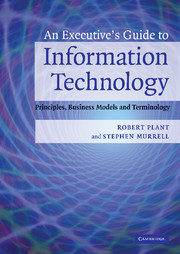Book contents
- Frontmatter
- Contents
- Introduction
- A ACM (Association for Computing Machinery) to Audio
- B Backup to Business process re-engineering
- C C, C++, C# to Cracking
- D Database to Dynamic web pages
- E e-Commerce/e-business to European Union Directive on Privacy and Electronic Commerce 2002
- F Fiber optics to Fuzzy logic
- G to H Global positioning system to Hypertext, HTML
- I ICANN (Internet Corporation for Assigned Names and Numbers) to ISP (Internet service provider)
- J to L Java to Logic programming
- M Machine learning to Multicast
- N Natural language processing (NLP) to Normalization
- O Object-oriented to Outsourcing
- P Packet switching and circuit switching to Public key-private key
- Q to R Quantum computing to RSS (Really simple syndication)
- S Sarbanes-Oxley Act of 2002 (SOX) to Structured design methodologies
- T to U T-Carrier to URL (Uniform resource locator)
- V Value added network (VAN) to Voice over IP (VoIP)
- W W3C (the World Wide Web Consortium) to WYSIWYG
- X to Z X.12 to Zip
- Index
- References
N - Natural language processing (NLP) to Normalization
Published online by Cambridge University Press: 17 May 2010
- Frontmatter
- Contents
- Introduction
- A ACM (Association for Computing Machinery) to Audio
- B Backup to Business process re-engineering
- C C, C++, C# to Cracking
- D Database to Dynamic web pages
- E e-Commerce/e-business to European Union Directive on Privacy and Electronic Commerce 2002
- F Fiber optics to Fuzzy logic
- G to H Global positioning system to Hypertext, HTML
- I ICANN (Internet Corporation for Assigned Names and Numbers) to ISP (Internet service provider)
- J to L Java to Logic programming
- M Machine learning to Multicast
- N Natural language processing (NLP) to Normalization
- O Object-oriented to Outsourcing
- P Packet switching and circuit switching to Public key-private key
- Q to R Quantum computing to RSS (Really simple syndication)
- S Sarbanes-Oxley Act of 2002 (SOX) to Structured design methodologies
- T to U T-Carrier to URL (Uniform resource locator)
- V Value added network (VAN) to Voice over IP (VoIP)
- W W3C (the World Wide Web Consortium) to WYSIWYG
- X to Z X.12 to Zip
- Index
- References
Summary
Foundation concept: Artificial intelligence.
Definition: The development and use of techniques to understand natural language input and to formulate an intelligent response.
Overview
Since the earliest days of computing, the idea of interacting with a machine through speech has been very appealing. To do so requires solving two problems: firstly, a system must be able to take a captured audio signal and recognize the words within it; and secondly, the system then has to be able to understand what the whole thing means. Researchers have been working upon both of these problems and have achieved a certain degree of success in each. It is not uncommon for business users to interact with airline reservation systems, for example, through an automated voice-recognition system. Many of the more successful systems bypass most of the first stage by accepting only typed input, not audible speech.
The origins of Natural language processing (NLP) are almost as old as computing itself. In the 1950s and 1960s researchers began to develop a variety of techniques aimed at understanding the ways computers could be used to provide NLP. One such system, Eliza, was created by Joseph Weizenbaum, whose system pretended to be a psychologist with whom a dialog could be enacted; a typical interaction with Eliza might start like this:
Eliza: How are you?
Human: I'm feeling ill.
Eliza: How long have you been feeling ill?
Human: Just a few days.
Eliza: Do carry on.
- Type
- Chapter
- Information
- An Executive's Guide to Information TechnologyPrinciples, Business Models, and Terminology, pp. 221 - 232Publisher: Cambridge University PressPrint publication year: 2007



